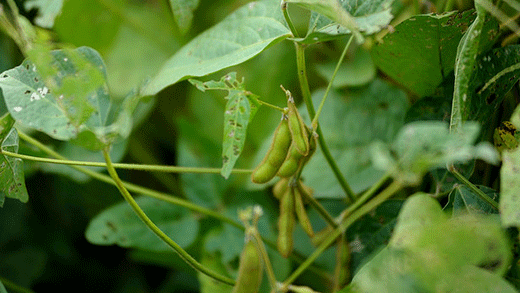
Kansas State University agronomist Ignacio Ciampitti is leading a project that involves seven U.S. universities that are aiming to maintain the protein in soybeans even as yields increase. | File photo
K-State researcher looking at ways to boost soybean quality
Project aims to maintain protein as yields go up
April 10, 2020
MANHATTAN, Kan. – A Kansas State University researcher is on the hunt for ways to improve the quality of soybean seeds so that the crop continues to maintain high levels of protein as crop yields increase.
Ignacio Ciampitti is leading a three-year study that involves six other U.S. universities and one private consultant. Their work is supported by the United Soybean Board, which has invested nearly $1.5 million for more than three years.
In addition to K-State, the project includes researchers at South Dakota State, Iowa State, Arkansas, Illinois, Purdue and Minnesota. Dan Davidson, a private consultant in Nebraska, is also part of the project.
“What we are doing is looking at this idea of how we can improve seed quality,” said Ciampitti, a crop production and systems specialist with K-State Research and Extension. “We know that when soybeans have higher yields, such as 60 to 80 bushels per acre, protein levels in those plants decline. As agronomists, we are always trying to improve yields, but at the same time we want to preserve the quality of that seed because that is what end users are buying.”
Kansas farmers typically harvest just a little more than 200 million bushels of soybeans per year, at an estimated value of $1.6 billion, according to information from the Kansas Soybean Commission. Soybeans have hundreds of uses, including such industrial products as engine oil and biodiesel, but are mostly used for animal feeds and cooking oils.
Ciampitti said the research group found early in the project that protein and amino acids tended to decrease in U.S. soybeans from southern to northern regions, findings that were first reported in the journal, Scientific Reports.
The researchers also think that applying small amounts of applied nitrogen to soybean fields – less than 50 pounds per acre – might improve the composition of amino acids in the plant, “but more research on this is in progress,” Ciampitti said.
They found that diverse rotations with other crops can give soybeans a protein boost, and some agricultural management practices – no-till, early planting dates, lower seed populations and others – help the crop to maintain its protein content at harvest. That work was recently cited in another scientific journal, Frontiers in Plant Science.
Ciampitti noted that the researchers have found mixed results when testing inoculants, such as rhizobia, on soybean seeds. “We believe there may be possibilities for using inoculants, but so far we have only had one study in which we see positive results,” he said.
But, he added, “when we are trying to expand the soybean frontier, there may be possibilities to explore if inoculating seed could help farmers. Based on my past experience, I have seen inoculants improve yields by two to five bushels per acre, but this also depends on the interaction of such factors as soil and weather conditions.”
That work, too, has been peer reviewed and published, recently appearing in Scientific Reports, through the online journal Nature Research.
Additional studies have found that while protein content may decrease in some soybean fields, the level of carbohydrates and other complex sugars may be increasing. That could be beneficial in some livestock systems where farmers are feeding soybean meal to pigs, for example. Carbohydrates provide energy which help animals grow more safely and efficiently.
“We are exploring all the possibilities at this point,” Ciampitti said. “We have evidence for the first time that there has been a change in the composition of soybeans, which will lead to a new (research) effort on improving our understanding of changes in soybean seed quality.”

